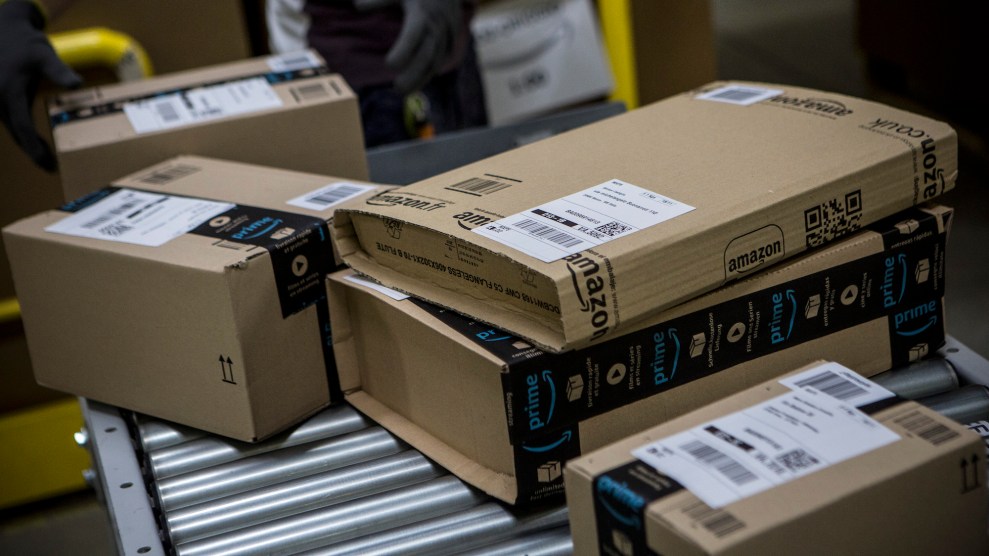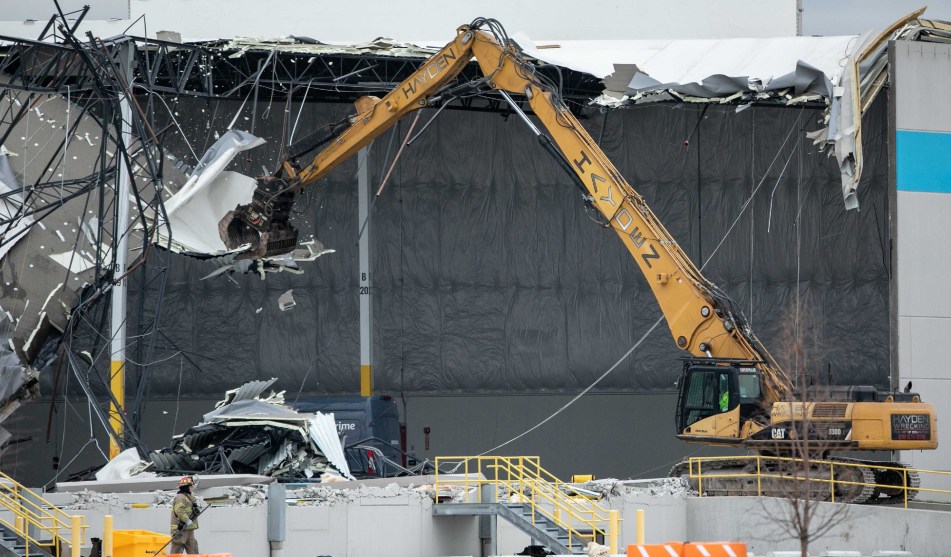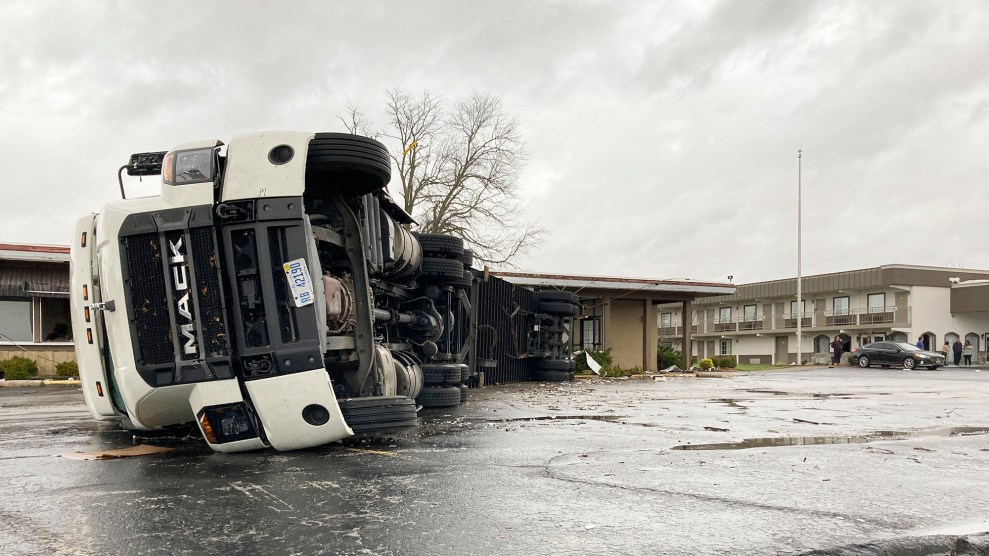
Emanuele Cremaschi/Getty
Jennifer Crane pulled a 50-pound tote off the conveyor belt, boxed it up at her station, and pushed it back on the belt to be labeled and shipped. Mindful of her quota—70 packages an hour for up to 11 hours—she grabbed a 20-pound box and felt pain shoot up her arm. Amazon’s medical team told her to finish her shift. That night, an MRI revealed a torn ligament in her wrist.
“I was sent back to work with the expectation to meet my normal rate or face discipline,” Crane told reporters during a press conference held by the Athena Coalition, an organization opposing Amazon’s “unchecked” power. Two of Crane’s sons work at SL8, and she fears for their safety, too. “Amazon won’t take responsibility for how dangerous they are,” she says. “They push us at unrealistic speeds that strain and hurt our bodies.”
Recent investigations by the Occupational Safety and Health Administration have found that Amazon is continually failing to keep workers like Crane, a packer at a St. Louis–area warehouse, safe from back injuries and other serious, chronic muscular disorders. The agency concluded that Amazon was endangering employees in at least six warehouses across five states—an unprecedented geographic range for its inspections—in part with intense productivity quotas that drive an injury rate of 6.8 per 100 workers, more than double the industry average. Eric Frumin, health and safety director of the Strategic Organizing Center, a labor union coalition, said OSHA may have just conducted “the broadest investigation by the Labor Department in all of history.”
The total fines were paltry: $107,144 in total, or 0.00000021 percent of the company’s 2022 revenue. (Amazon, which “strongly disagrees” with OSHA’s findings, plans to appeal them.) But the fines and investigation are nevertheless “historic,” say many labor experts and former OSHA officials, signaling an era in which US regulators will pursue real consequences for the shipping behemoth—starting, in this case, with more sustainable quotas and a safer workplace.
“They need to take these injuries seriously and implement a company-wide strategy to protect their employees,” said OSHA assistant secretary Doug Parker. Amazon, Parker said, was failing to address “well-known and preventable hazards.”
“When we order that two-day shipping at Amazon, there is no magic technology,” said Sheheryar Kaoosji, director of the Warehouse Worker Resource Center, a nonprofit dedicated to improving warehouse conditions in Southern California. “What gets that product to you quickly is talented, hard-working, overstrained humans rushing.”
Despite efforts to rebrand as “Earth’s safest place to work,” the company has been getting more dangerous. A recent report from the Strategic Organizing Center found that injuries were up 20 percent in 2021, and that 89 percent of those injuries were debilitating enough to prevent workers from doing their job. That year, at an Amazon center outside Albany, New York, one in five workers was injured on the job. Amazon is the second-largest private employer in the country, and in some regions the primary one; injuries linked with its relentless productivity rates stand to debilitate those communities.
OSHA’s charter, the Occupational Safety and Health Act, is a notoriously weak law enforced by a chronically underfunded and under-resourced agency. Amazon paid nothing when warehouse workers were killed by a roof collapse during a 2021 tornado, despite the presence of identified risk factors and demands for workers to finish their shifts.
Even though musculoskeletal injuries and disorders “can be incredibly painful and life-altering,” said Debbie Berkowitz, a chief of staff and advisor to OSHA under the Obama administration, fines like Amazon faces “are really rare citations, because OSHA doesn’t have a specific standard” for the hazards that cause them. She says there’s only been one ergonomic citation in the Biden administration so far, and only one during the Trump administration—which was backlogged from under Obama. When there’s no specific standard for a hazard—like musculoskeletal injury, workplace violence, or heat—OSHA relies on an employer-friendly “general duty clause” that’s vague and notoriously difficult to enforce, with an extraordinarily high burden of proof. OSHA has to prove that the employer knew about the recognized hazard; that the hazard caused injury or death; and that a feasible solution was available. In 2018, about 1.5 percent of OSHA’s citations were issued under the clause.
The federal investigation complements one still underway at OSHA’s counterpart in Washington, Amazon’s home state, which has already cited the company for hazardous workloads and injury rates worsened by its high-pressure discipline system. Amazon is appealing those citations as well, and still hasn’t created an abatement plan that was due last March. Its workplace safety issues are also being being investigated by the Southern District of New York. The Strategic Organizing Center has also filed a complaint with the Securities and Exchange Commission to request an investigation into what Frumin calls Amazon’s “misleading” health and safety disclosures to investors.
With ongoing appeals, it isn’t likely that we’ll see immediate change for workers like Crane. But there’s “only so much denial that Amazon can do,” says Berkowitz. Upheld, the citations set the stage for steeper fines—”willful” violations, like those repeated after a citation, can be ten times more costly—and help establish a pattern of worker endangerment. That’s groundwork for court orders forcing Amazon to address warehouse conditions, and potentially for even more sweeping inspections. Also possible: a chilling effect on the “Amazonification” of the American workforce, in which smaller companies look to impose Amazon-style quotas and practices.
After her injury, Crane joined a workplace organizing committee. She is calling on OSHA to investigate her warehouse next.













